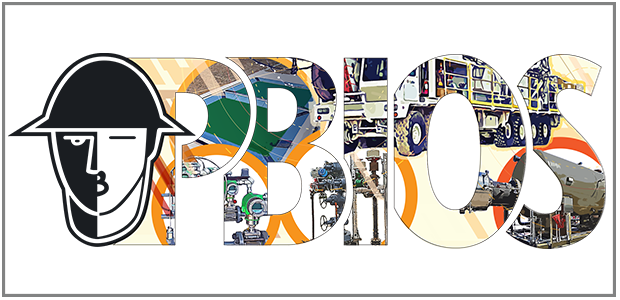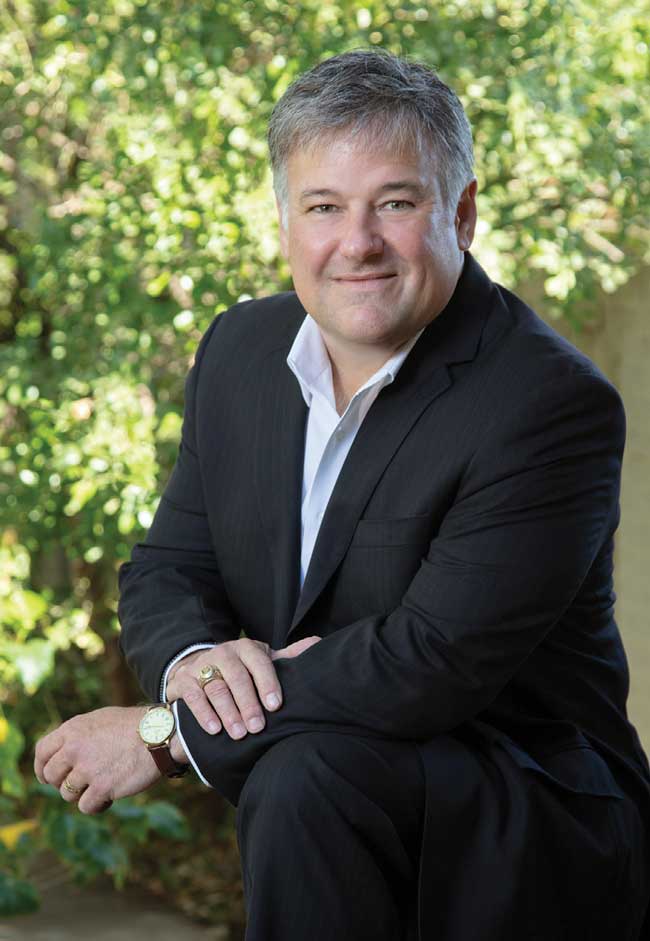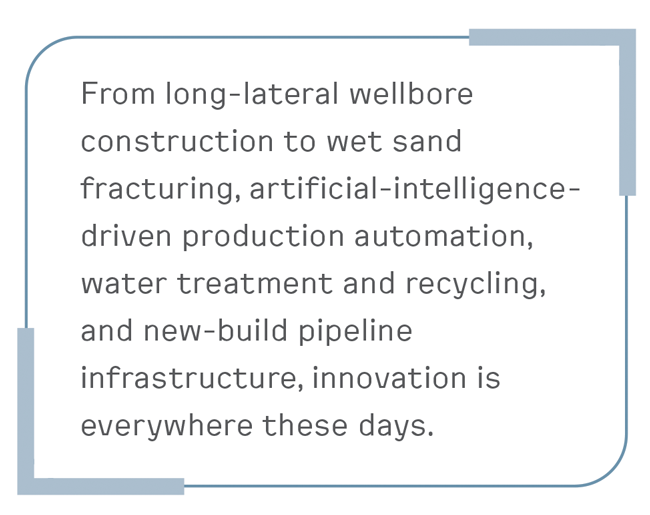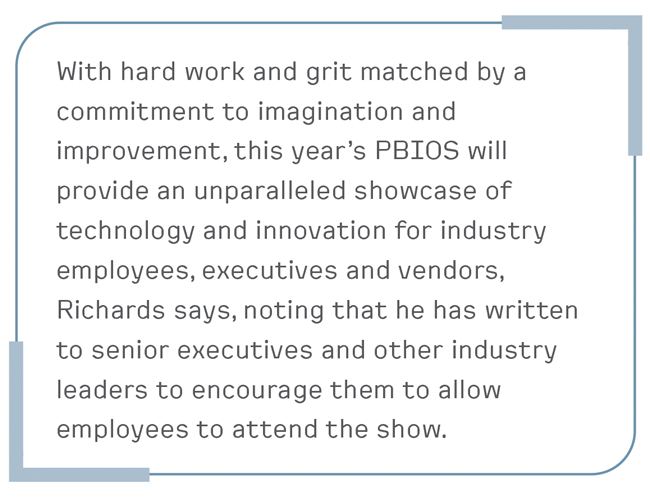
An AOGR Special: Larry Richards | 2023 PBIOS Highlights Innovations
By Danny Boyd Special Correspondent
ODESSA, TX.–The Permian Basin has always been something of a proving ground for new technology development, but throughout the storied history of the Permian Basin International Oil Show, rarely has technology been more integral to the day-to-day operations of drilling, completing, producing, treating, processing, storing and transporting oil and gas. From long-lateral wellbore construction to wet sand fracturing, artificial-intelligence-driven production automation, water treatment and recycling, and new-build pipeline infrastructure, innovation is everywhere these days.
Moreover, while the basin has long been a crucial hub of domestic crude oil supplies, rarely has it played a more dominant role in the global oil and natural gas supply picture. According to the U.S. Energy Information Administration, annual volumes of both oil and gas production have doubled during the past five years, helping make it possible for America to become a dependable exporter of vital oil, gas and refined products to overseas allies.
PBIOS President Larry Richards has occupied a front row seat to the technology-enabled transformation that has elevated the Permian to the status of global unconventional oil and gas superstar. He says the theme for the 2023 show, “Where innovation and technology meet Permian grit,” is a perfect fit.
Much of the innovation, Richards points out, has emerged from drilling and completion work within 150 miles of the Ector County Coliseum and Fairgrounds in Odessa, the site of the 39th biennial PBIOS, scheduled for Oct. 17-19.
With hard work and grit matched by a commitment to imagination and improvement, this year’s PBIOS will provide an unparalleled showcase of technology and innovation for industry employees, executives and vendors, Richards says, noting that he has written to senior executives and other industry leaders to encourage them to allow employees to attend the show.
“Industry activity is often either red hot or slowing down, but in either instance, field personnel are under a lot of pressure, so it is hard to break away,” he acknowledges. “But I truly believe in my heart that PBIOS is one of the best investments companies can make in their field hands, young engineers and procurement personnel. Companies can make it easy for them to take a half day or a full day to walk around the show to see all these innovations and technologies and services that will help them do their jobs more easily, more efficiently and more safely.”
The dictionary lists several definitions for “grit,” Richards observes. One describes grit as a small, loose particle of sand or stone. Another defines grit as courage, resolve, perseverance and strength of character.
“Both of those definitions are applicable to the Permian region and the men and women in our industry who work in the basin on a daily basis,” Richards insists.
Advancements, including those developed since the 2021 PBIOS, emerge from a strong set of entrepreneurial values that are coupled with a very practical need to complete the highest-quality well site work in the most efficient and safest way possible under sometimes challenging conditions, he says.
“I have found during my career in the Permian Basin that an entrepreneurial spirit allows for a lot of entrepreneurial thinking, but the key focus is always on whether a particular solution works when it is 120 degrees, covered in sand, and has a large reptile trying to crawl through every hole in the piece of equipment.” Richards quips.
Investment Of The Year
PBIOS’ 150-member board represents all facets of the Permian Basin industry and aims to make the 2023 show the year’s best marketing investment for all sizes of exhibitors, regardless of the particular industry segment in which they are engaged, Richards indicates.
In July, 715 exhibitors were registered, with more on a waiting list, reports PBIOS Executive Director Tony Fry. “We are still a couple of months out and getting phone calls on a regular basis and applications for spaces continue to come in,” he says.
Historically billed as a “working man’s oil show,” PBIOS is deploying its own innovation to reach out to people at every rung of the oil and gas industry ladder, Fry explains. The organization has produced videos on its website for this year’s biennial show to help expedite registration, parking, and exhibit setup and disassembly. The videos are intended to help attendees prepare for the show as part of PBIOS’ work to create a quality experience for both exhibitors and attendees, he adds.
To help attendees get the most out of the experience, Richards says PBIOS has helped lead efforts to improve the coliseum and fairgrounds, with obvious results including the new coat of paint the entire facility received this summer. “The show also has donated $282,000 to local universities and colleges this year to support their internal engineering and technical programs,” he relates.
All the preparation will help make the show a rewarding experience for everyone involved, he predicts. “I worked my company’s booth at the last show and was amazed at not only how many field personnel and engineers attended, but how many senior executives at oil and gas companies walked through the show,” Richards recalls.
An exhibitor for 26 years before retiring in 2022, Richards has been on the PBIOS Board of Directors for the past 20 years and the PBIOS Executive Board for a decade.
“Larry has been tremendous to work with, and he is a great spokesman for the show,” Fry says. “He can author articles and is comfortable in front of a camera when needed. He loves the show, and he’s extremely knowledgeable of all phases of the oil and gas industry. He is a great PBIOS president.”
Richards says he has witnessed advancements and innovations throughout his life that continually have revolutionized the oil and gas business, including those that continue to keep the nation’s premier oil province humming.
Richards reflects that U.S. basins have come a long way since the 1960s, when his father worked in the Permian as area superintendent for Getty Oil Co. Some of today’s most prolific areas were considered almost exhausted by conventional methods in the late 1960s. “My dad passed a few years ago, but he is still my role model and hero today,” Richards states. “He would be thrilled to see the advancements and innovations our industry has seen over the past decade.
“There’s a reason so many companies want to be active in the Permian,” he adds.
Today, the Permian is flowing oil and gas at record volumes as operators deploy cutting-edge techniques and technologies to drill, complete and produce wells, and to treat and transport production streams, Richards says. New products and services continue to emerge every day to deal with high rates, high pressures, sand production, water treatment, emissions and more. And the solutions developed in the Permian then help boost drilling, completion and production results in other U.S. shale and tight oil plays, he points out.
Oil Industry History
Richards moved his family from Houston to Midland in 1997 and immediately got a firsthand view of the grit, he recounts. During its first afternoon in town, the family endured a genuine West Texas sandstorm, followed quickly by rain that created falling mud balls and then golf-ball-sized hail.
“In our first 72 hours, we found a bat and a scorpion in our pretty new kitchen, and it’s a miracle my wife didn’t head back to Houston without me,” Richards jokes. “This area that is not for the timid, but if you love technology and you love challenges, it is a really fun place to work.”
Richards grew up in southern Louisiana near New Orleans and graduated from high school in Kingwood, Tx., north of Houston. His exposure to the oil field began early in life from his father’s 35 years at Getty, Richards says. After high school came studies at Texas A&M University, where Richards met his wife, Sondra. The couple has two grown sons.
During college, his oil and gas career began on a roustabout crew as part of Sun Oil’s engineer training program. His experiences during two summers exposed him to heavy oil production operations in East Texas and high-pressure gas operations in South Texas.
“It gave me a tremendous amount of respect for the hard work and the daily field conditions those folks work in,” Richards remarks.Initially a petroleum engineering major, Richards opted for a degree in business management, influenced by the oil and gas industry bust of the mid-1980s.
“I do not mind working hard. But I did not want to work that hard in college and not have a job available after graduation,” he comments. “My engineering background has helped tremendously in my career. I have had the opportunity to work with and manage some wonderful engineers over the years. I have a respect for their discipline and what they go through to find solutions.”
For the first decade of his career, Richards worked at Continental Emsco, which at the time was the nation’s second-largest rig manufacturer, with more than 200 supply stores in North America. Richards eventually oversaw product lines that included Emsco drilling rigs, Wilson well service rigs, a full line of production equipment and offshore mooring systems.
At the time, oil and gas innovation mainly centered on offshore enterprises, Richards recounts, and so he made frequent trips to work with companies active in the United Kingdom and Norwegian sectors of the North Sea, as well as in deepwater projects in the Gulf of Mexico and offshore Brazil. Eventually, the company appointed Richards head of its companywide sales and marketing efforts, he says.
After his due diligence led him to recommend that Continental Emsco should purchase Permian-based Gregory Rig Service, Richards left Houston for Midland to run the new acquisition.
National Oilwell purchased Continental Emsco in 1999, which created an opportunity for a new start. Richards accepted a newly created position at Key Energy Services in Midland: vice president of operations support. At Key, the largest U.S. well servicing company at the time, Richards oversaw equipment standardization, rig and trucking equipment teams, refurbishment operations, asset management and national vendor agreements, he says.
In 2003, he left Key to become chief executive officer of HyBon Engineering in Midland. There he led a team for which the annual growth rate averaged better than 25% before the company sold in 2014. Noncompete restrictions prompted Richards to begin looking at other oil and gas-related options. He and some partners teamed with private equity firm OFS Fund to invest in a young entrepreneur’s Odessa-based company, VanZandt Controls. Together, they grew annual revenue to more than $50 million in five years.In a deal that benefitted both employees and the management team, the company sold in 2022, and Richards officially retired, but he continues to sit on several corporate boards and support Permian entrepreneurs. “I am so thankful to my wife and family, and all the mentors and wonderful friends I have made along the way; it’s been a great ride,” he says. “Most of all, I praise God.”
Telling The Industry’s Story
Richards says one of his chief personal goals is to help the industry proudly tell its story. For example, most people are unaware of the industry’s worldwide impact on lifting populations out of poverty, he says. In 2023, less than 10% of the world population meets the United Nation’s definition of living in abject poverty, he notes. In 1820, and every century before, that figure had been at least 80%.
Oil and gas production, beginning with the first Drake well in 1859, is responsible for much of that material progress because it has provided low-cost energy and fuel for manufacturing, agriculture, heating, cooling, transportation, construction, and more, as well as a host of inputs for medical and consumer products, he observes.
Grain prices rise with natural gas prices because two key ingredients in synthetic fertilizer—ammonia and urea—are processed from natural gas, Richards points out. About 50% of the global food supply cannot be produced without synthetic fertilizer, but conversations about eliminating hydrocarbons rarely include any of this basic information on the contributions that hydrocarbons make to the quality and sustainability of human life, he says.
“As an industry, we have to constantly improve and focus on reducing emissions and being good stewards of the environment, but I also think we need to tell our story about the amazing impact we have had on the standard of living and the livelihoods of every American,” Richards concludes.
For other great articles about exploration, drilling, completions and production, subscribe to The American Oil & Gas Reporter and bookmark www.aogr.com.
















